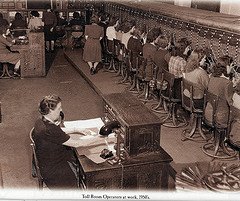 The 1-800 number got its start in 1967, the same year Che Guevara was executed and Aretha Franklin recorded “Respect”. The idea was to cut down on collect calls, which could be labor-intensive since they often required a live operator. The early adopters of toll-free numbers were primarily hotels and car rental companies, which took lots of reservations from across the country over the phone. Because of this, the story of toll-free numbers is also the story of the modern call center.
The 1-800 number got its start in 1967, the same year Che Guevara was executed and Aretha Franklin recorded “Respect”. The idea was to cut down on collect calls, which could be labor-intensive since they often required a live operator. The early adopters of toll-free numbers were primarily hotels and car rental companies, which took lots of reservations from across the country over the phone. Because of this, the story of toll-free numbers is also the story of the modern call center.
When the first call center went belly-up, the companies involved in its operation immediately stepped in to retain its infrastructure as well as the expertise of its employees. Before long, independent call centers cropped up for each company that required one, but they all remained in the same area: strip malls at 93rd and Bedford in Omaha, Nebraska. There were so many call centers in the neighborhood that it became known as “Res City”. AT&T even opened an office there – so if you wanted a new toll free number in Omaha, you could get it up and running within 24 hours. If you were anywhere else, you might have to wait for weeks.
A lot of the reason for the delay was the cumbersome way in which toll-free calls were originally handled. If a LEC (local exchange carrier) got an 800 call that wasn’t in-state, it would simply pass the call to AT&T and force it to handle the routing. This meant that every company actually needed two 800 numbers: one for in-state calls and a second for out-of-state calls.
The system was upgraded in 1981 with Common Channel Interoffice Signaling and the Network Services System database. These technologies allowed AT&T to handle all 800 numbers, in- or out-of-state, through a central clearinghouse. AT&T also gained the ability to offer customized 800 numbers – a service that would eventually become the vanity numbers we see today.
For vanity numbers to really take off, however, customers needed to be able to take their 800 number to whichever phone company they wanted to use. It wasn’t until the FCC mandated 800-number portability in 1993 that telecom customers were able to pick any carrier they preferred and bring their toll-free numbers with them. (Previously, switching carriers required firms to begin using new toll-free numbers – a costly and complex proposition.)
The resulting boom in the use of vanity numbers threatened to use up the remaining 1-800 options, so new toll-free prefixes were created: 866, 877 and 888. Today, competition has lowered prices to the point where individuals can afford their own toll-free numbers, either for the convenience of their families or for home-based businesses.
Photo credits: KaCey97007, kiwanja.
Originally published Apr 27, 2009, updated Oct 24, 2022



